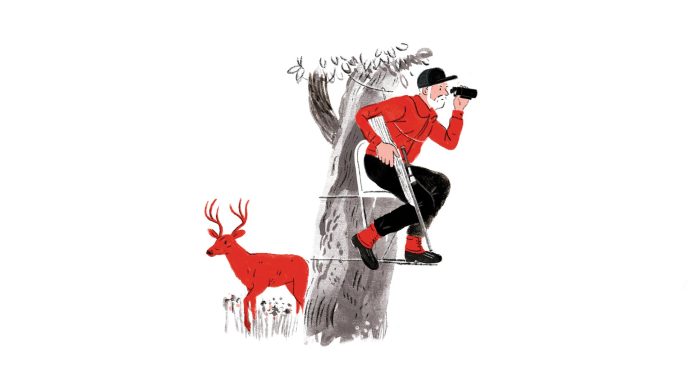ONE LOOK at the words outstanding bargain in an old Sears catalog, and I knew what had attracted Granddad all those years ago to the .22-Caliber Ranger Single Shot Rifle. The price was $3.79. Even by 1930s standards it was a deal, and there isn’t much that Heavey men like better. For 46 cents more you could get it with a hooded front sight and a rear peep, but Granddad wouldn’t even have been tempted by so reckless an expenditure. The rifle is an M34, made in the USA for Sears, reportedly by Marlin, although there’s no way to tell. And with no serial number, there’s no way to date the gun. It came with a pistol grip, a chrome-plated bolt handle, and a walnut finish. Back then, it was a first gun a boy would dream of.
Ninety years later, my father and grandfather are both long gone. So I cradle the rifle they handed down to me, run the bolt, and miss them. Granddad lived 78 years, Dad 87. Those numbers are of more than academic interest to me these days. Neither outlived the gun, and it’s already older than I am. If cared for, a rifle lasts for centuries.
I love this gun. It’s perfect in the way that canoes are perfect. Anything more would be superfluous. Anything less would be incomplete.
Granddad was probably a major or lieutenant colonel by 1935, posted in the Panama Canal Zone with the Corps of Engineers. My father, Bill Jr., and his younger brother, John, must have counted the days until the rifle arrived. They had a range in the basement of the family quarters, the targets backed by a sheet of heavy steel that Granddad had angled to send the bullets down into a sandbox. Dad collected the lead, heated it, and poured it into molds to make toy soldiers. Granny wouldn’t have liked shooting in the house, but she was already a veteran Army wife and picked her battles. She was a skilled rider and played polo with the men on the post. They probably weren’t stationed there long. Granddad was an officer on his way up. I know only the few things Dad told me about that time: As a Boy Scout, he was taught to look for snakes first on the ground, then in the trees, when he was walking through the woods. He once shot a fer-de-lance—a highly irritable serpent, still Panama’s deadliest—that had invaded his tree fort. Also, whether by proclivity or compulsion, my father ate so many bananas there that they were the one food he would not consume as an adult.
The Heaveys came over from Ireland during the potato famine and found work as cops, priests, and soldiers. A Depression youth, Dad was as cheap as Granddad and proud of it. The gene passed to me as surely as blood type. I remember once waking up to a new pair of orange jeans I’d bought at an outlet mall the evening before. They were hideous, purchased only because I was stoned out of my mind on thrift as I kept discovering cheaper and cheaper jeans that could be had if you didn’t mind fewer belt loops, a slightly lighter-weight fabric, or a less desirable color. Like orange. The girl I was seeing at the time threatened to dump me if I ever wore them. I didn’t.
As a boy, I had a standing Sunday appointment with the .22 at my grandparents’ apartment in D.C. We would stop by for brunch on our way home from a church service that lasted an ice age. Granddad was by then a retired brigadier, his medals framed on a piece of black felt: three Purple Hearts, a Bronze Star, a pile of other medals and ribbons about which I had no clue. He’d take me aside and murmur, “My little .22’s waiting for you in my closet.” Then I’d lie on the Persian rug in my Sunday clothes, dry firing, methodically dispatching books and furniture legs. Ankles were off-limits.
My father wasn’t a hunter and, like his father, had seen too much combat to have any interest in recreational shooting. He gave the gun to me. I lived in D.C. at the time, so I loaned it to my best friend, whose family had a farm in Virginia. Once I asked him how the gun was faring. “It’s the most accurate gun we’ve got at the farm,” he told me. “We keep it in the bathroom.” He had dispatched quite a few groundhogs while sitting on the john. “It loves those little 40-grain CCI subsonics,” he said.
I’ve long worried about the gun’s fate after me, wondering if anybody would ever cherish it in the way it deserved. When Emma and her fiancé, Blake, visited from Texas in December, I showed him the rifle and told him it would be his one day. I remember watching as he disappeared into the gun. His whole being conformed and committed to it as he swung along the lines of the room. Blake is basically a cowboy and not the most talkative young man, but he was smiling when he handed it back. I nodded to him ever so slightly, the acknowledgment of one man to another, and zipped it back in its sleeve. That night, as Emma and I did the dishes, she leaned in and whispered, “No kidding. You just made his year.” I smiled. I had done my duty, acquitted myself honorably. The gun was safe for another generation.
Read more F&S+ stories.








